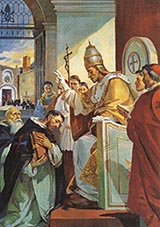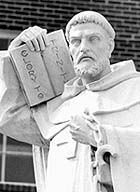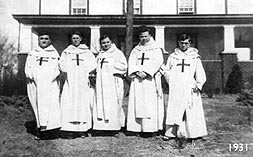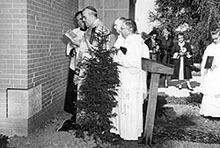
 |
![]()
 The Trinitarians were founded by St. John de Matha and St. Felix of Valois
at the end of the 12th century. From the outset, a special dedication
to the mystery of the Holy Trinity has been a constitutive element of
their life, the beginnings of which are deeply rooted in the Crusades.
The founding intention of John was the ransom of Christians held captive
by nonbelievers, a consequence of crusading and pirating along the Mediterranean
coast of Europe.
The Trinitarians were founded by St. John de Matha and St. Felix of Valois
at the end of the 12th century. From the outset, a special dedication
to the mystery of the Holy Trinity has been a constitutive element of
their life, the beginnings of which are deeply rooted in the Crusades.
The founding intention of John was the ransom of Christians held captive
by nonbelievers, a consequence of crusading and pirating along the Mediterranean
coast of Europe.
The Order and the Rule of St. John de Matha were approved by Pope Innocent III on December 17, 1198. The Order’s distinctive cross of red and blue can be traced to its beginnings.
 Along with the Order’s mission of ransoming Christian
captives, each Trinitarian Community served the people of its area by
performing works
of mercy. Thus redemption and mercy are at the very center of the Trinitarian
charism.
Along with the Order’s mission of ransoming Christian
captives, each Trinitarian Community served the people of its area by
performing works
of mercy. Thus redemption and mercy are at the very center of the Trinitarian
charism.
First generation Trinitarians could count some 50 foundations throughout France, Italy, Spain, Portugal, Luxembourg, Scotland, England and Ireland. Ransoming captives required economic resources and the Trinitarians set aside 1/3 of all income for this purpose.
The Order continued to grow. By the end of the middle ages there were twelve provinces of Trinitarians with approximately 150 houses in Europe. The late 16th century was a time of reform in the Church and in the Order. St. John Baptist of the Conception received papal approval in 1599 for the Spanish Discalced branch of the Order. Today’s Trinitarians are the direct descendants of this reform movement.
 Political
situations during the 16th through 19th centuries had devastating effects
on the Trinitarians. The Order's houses in England, Scotland
and Ireland were closed during the reigns of Henry VIII and Elizabeth
I. Suppressions in the Austro-Hungarian Empire, Spain, Portugal, Italy
and
Poland, as well as the French Revolution, led to a decline in the Order’s
presence. By 1873 there were only a handful of Trinitarians living in
a few houses, all located in Rome.
Political
situations during the 16th through 19th centuries had devastating effects
on the Trinitarians. The Order's houses in England, Scotland
and Ireland were closed during the reigns of Henry VIII and Elizabeth
I. Suppressions in the Austro-Hungarian Empire, Spain, Portugal, Italy
and
Poland, as well as the French Revolution, led to a decline in the Order’s
presence. By 1873 there were only a handful of Trinitarians living in
a few houses, all located in Rome.
Since the late 19th century, restoration of the Order has been taking place. Trinitarians may be found in the United States, Canada, Mexico, Argentina, Bolivia, Brazil, Chile, Columbia, Guatemala, Peru, Puerto Rico, Austria, France, Italy, Poland, Spain, Congo, Egypt, Madagascar, India and South Korea.
Trinitarians from Italy arrived in the United States in 1906. In 1911 the Order was entrusted with the care of Italian immigrants at Our Lady of Mt. Carmel Parish in Asbury Park, New Jersey. Parishes in Long Branch, New Jersey, Bristol, Pennsylvania, and Trenton, New Jersey were to follow. St. John de Matha Monastery was established in Hyattsville, Maryland in 1931.
 Within forty years of their arrival in the United States,
Trinitarians could be found in parish ministry from the east coast to
Texas and
had opened the doors of DeMatha Catholic High School in Hyattsville,
Maryland.
In 1950 the Province of the Immaculate Heart of Mary was established
with Fr. Cyprian Nusca, O.SS.T. as its first Minister Provincial.
Within forty years of their arrival in the United States,
Trinitarians could be found in parish ministry from the east coast to
Texas and
had opened the doors of DeMatha Catholic High School in Hyattsville,
Maryland.
In 1950 the Province of the Immaculate Heart of Mary was established
with Fr. Cyprian Nusca, O.SS.T. as its first Minister Provincial.
In 1955, the cornerstone for Sacred Heart Monastery (now known as Holy Trinity Monastery) was laid in Pikesville, Maryland. This facility located in the beautiful Green Spring Valley region of Maryland serves today as Holy Trinity Spiritual Center.
<<BACK TO TOP>>